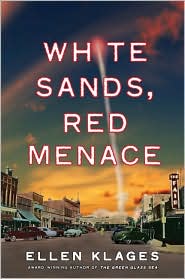
In the sequel to The Green Glass, Klages continues the 1940s story of Suze and Dewey, two young girls who have spent the last several months living at the research community where the atomic bomb was develop. Dewey's father and both of Suze's parents were scientists working on the project. Toward the end of the last book, Dewey's father had passed away due to an accident, and Suze's parents took her in.
Suze and Dewey's friendship was off to a bumpy start, but they have since grown to be just like sisters, though they refer to each other as brothers (as in blood-brothers) since they aren't actually sisters.
With the war over and the world happy to see it over and quite traumatized by the results of the bomb, the girls and their family have moved from Los Alamos to Alamogordo, New Mexico. Suze's father has started working on the White Sands rocket project. This project is using the recovered parts (and even many of the Nazi scientists) from the German V2 rocket project to begin a space program. It keeps Dr. Gordon quite busy.
Dr. Mrs. Gordon agreed to delay her return to university teaching for a year so her husband can work on the project. She had left the school in Berkeley to help the war effort, but she wants dearly to return to her life on campus.
Dewey is also confronted with a woman from the past: her biological mother. Dewey has often been made fun of over the years because one of her legs is shorter than the other. This was due to the fact that her mother dropped her when she was just a baby, which led to her leg being broken in three places. Out of fear, her mom ran off, leaving just Dewey and her father to fend for themselves. Now, Dewey's mom is looking to come back into the role, but Dewey is not sure she is willing to sacrifice her new family to do so.
The girls also get an opportunity to develop their social skills. Suze becomes friends with a Mexican girl who lives on the other side of town while Dewey finds first love. Dewey is also confronted with the challenges of being a girl as she wants to take shop and other science/engineering related courses at school, only to be forced into home economics instead.
As with the previous book, Klages does a wonderful job of making the reader feel like they are living in the times. She mentions in her Author's Note that this is a time period that is often overlooked, with history books often jumping right from the end of the war to the early Cold War in the 1950s. This novel does a nice job of filling in the blanks while doing so in an entertaining way.
I don't think new readers need to worry about having read the first novel. While a number of characters are carried over, and the first book does have some background in the area of character development, I think Klages has done a nice job of summarizing the important points for new readers.


